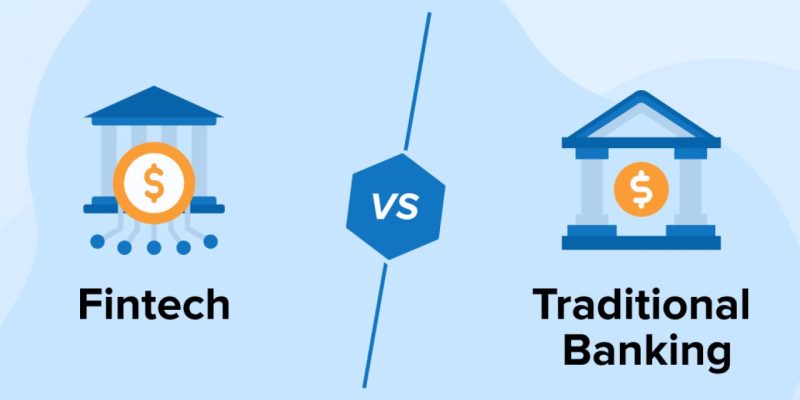The global outlook on finance has changed drastically over the last ten years. Even the common people’s banking alternatives can challenge traditional banks. This has introduced a new financial services platform R & D production Fintech companies always keep user experience, speed, and accessibility forefront. There are two separate questions now; one is whether Fintech will one day completely overshadow traditional banks.
Innovation and Flexibility vs. Trust and Tradition
There are two major advantages that Fintech has over traditional banks. In contrast to side-loading overheads of physical bank branches, Fintech companies such as these operate a digital-first platform. Take instant loans, stock trading, or transfer money with your mobile phone. This speed and efficiency provide a total shock for traditional banks, with their requirements for people to visit in person and slog through those long processing periods.
Even industries such as agriculture and heavy machinery are also delving into the innovations of FinTech. Today’s modern tractor funding platforms allow farmers to get high-end equipment with almost no need for paperwork whatsoever, and they are customized payments that make the All-important agricultural tools more available. Yet another piece of evidence for the all-around versatility and wide market appeal of Fintech lies in how it is transforming niche markets.
The Role of Trust and Regulation
Having held a firm grip on customer trust for many years, banks are still the gold standard for the Chinese people in any type of identifiable economic activity. Being heavily regulated institutions, they also have long traditions. Confronted with the near-collapse of individuals, families, and companies during the crisis of 1998-Baidu, its robust security measures and government-backed insurance (like deposit insurance) make a bank the preferred choice for those seeking safety savings. For its part, fintech startups confront challenges of regulation and security. Despite significant strides in cybersecurity, however, they are not yet seen universally as reliable as traditional banks
Nevertheless, regulatory environments are changing. Governments and financial bodies across the globe are developing policies for supervising fintech more efficiently-something which could level an increasingly unfair playing field here. In addition, partnerships between banks and fintech firms are becoming more common, combining the innovation of fintech with the reliability traditional institutions have long guaranteed.
User Experience and Accessibility
One reason driving the sharp rise of fintech is its superior user experience. Digital-native consumers especially millennials and the generation behind them–prefer services that acquiesce effortlessly on the Internet, with interfaces that make for seamless interaction. M-banking apps, automated savings tools, and AI-driven financial advisors have not only changed how people manage their money but transformed the very way they do so. For one thing, the allergic reaction many feel at having to wait in long lines just to deposit a few thousand yuan can never be experienced it’s like online. 24/7 service, personalized recommendations, and inquiries are answerable within seconds are also features that fintech platforms are quite commonly observed not to have in common with traditional banks.
Traditional banks, on the other hand, are still slow to adopt current technology. Many of them still have legacies overlying the systems that prevent them from innovating at the pace needed to meet customer expectations. However, the major banks have begun investing heavily in their own digital platforms and mobile banking services so as not to be disadvantaged by these developments.
Costs and Competitive Pricing
It is another area in which Fintech excels: efficiency with cost. Fintech companies are generally much lower in operation costs because they only have net (or no) branch networks. “ This enables them to offer very competitive prices “such as fewer charges for transactions, more favorable foreign exchange rates, and higher savings-retirement interest rates on Spain’s pension savings accounts.”peer-to-peer lending and crowdfunding platforms have also disrupted traditional lending by providing borrowers more flexible options.
Traditional banks are saddled with expensive outlays from manpower to premises; they also have the daunting cost of compliance. These institutions are, however, parlaying their financial strength into partnerships with fintech firms and experimenting with in-house innovations. In sum, the hybrid model blends digital low-cost solutions success together with hardened banking services on over centuries of experience.
Financial Inclusion
The introduction of fintech has been something of a game-changer in respect to financial inclusion. Where traditional banking services are few and far between, mobile-based financial services present a great opportunity that people can no longer ignore. Digital wallets, microloan programs, and blockchain-based platforms enable a previously underserved population to at last gain access to credit and payment systems.
For example, fintech platforms targeting rural farmers propose alternative payment arrangements that are volume-based, i.e. according to crop yields. Likewise, financing methods available for agricultural equipment (like plows) can be structured around farmers’ seasonal incomes. These advances are indicative of fintech’s potential to rejuvenate some of the economic sectors that traditional banks have long failed to reach.
Security and Privacy Issues
For consumers, security is an important factor in deciding between fintech & traditional banks. While banks have powerful security systems & tried-and-true routines themselves, the new-age services of fintech startups rely on innovations like blockchain, encryption, and many-factor authentication to successfully do what their more established competition does with user data. Nevertheless, because they are small startups with limited resources when compared to big banks, fintech startups have a high risk of suffering from cyber threats.
Customer education and transparency are critically important if security concerns are to be addressed. Therefore, cybersecurity becomes a top priority for fintechs as well as traditional banks in order to build trust and comply with the Data Protection Directive.
The Future of Banking
Some trends will shape the future.
-
Collaboration before competition:
The partnership between banks and microfinance agencies will only become more substantial, marrying innovation with solidity. More comprehensive regulatory frameworks for fintech will strengthen consumer security and market harmony.
-
The march of technology:
Artificial intelligence, blockchain, and open banking will soon reshape financial services delivery entirely.
Ultimately, it may not turn out to be a winner-takes-all situation in financial services after all. Instead, a hybrid model of co-existence for fintech and traditional banks might be the most sustainable approach. As development continues on both sides, customers can look forward to better innovation, security, and personalized experience.
Conclusion
The financial industry is in a whirl of changes. Fintech firms have disrupted state-of-art methods by offering speed, innovation, and convenience. Old banks, however, intact and indispensable are the places of trust, regulation, and reliability.
As technology advances, the difference or even dichotomy between fintech and traditional banks will disappear in reduction to nothing. A symbiotic future that might well recast world finance has been envisaged. For both consumers and businesses, the future is bound to bring thrilling changes and greater variety in the management of their financial resources.










Comments